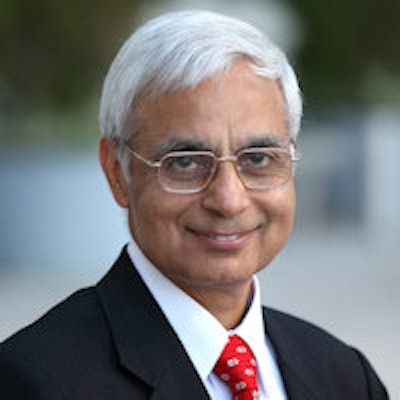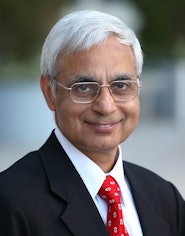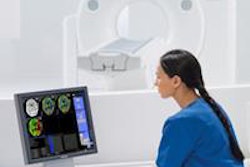
VIENNA - The mission of EuroSafe Imaging is to support and strengthen medical radiation protection across Europe following a holistic, inclusive approach.
Europe is unique and it has the potential for coordinated radiation safety actions in medical imaging.
So what makes Europe unique? In Europe, the European Atomic Energy Community (EURATOM) Directive is binding on European member states, and EURATOM has regulated medical radiation protection, including x-rays, since the 1990s.
 Madan M. Rehani, PhD, director of radiation protection, European Society of Radiology.
Madan M. Rehani, PhD, director of radiation protection, European Society of Radiology.
No other region, or country, has something similar. In the U.S., each state has its own regulatory mechanism for x-rays, as federal laws regulate the use of radioisotopes in medicine (nuclear radiation), through the Nuclear Regulatory Commission (NRC), but not x-rays. The requirements issued by the International Atomic Energy Agency (IAEA) are not binding on IAEA member states; they are voluntary international standards.
In the 1990s, when the Maastricht Treaty was signed, there was a vision to have something like a standardized European x-ray image, such that when the patient travels from one European country to another, there could be validity of the image and thus avoiding repeat imaging. This led to the development of quality criteria for image quality that included patient dose as well. Europe also established diagnostic reference levels (DRLs) that became one of the most important tools for optimization in patient radiation protection. The European Commission has supported these developments through a variety of projects.
While the directives need to be incorporated into national regulatory systems by European member states, Europe's largest radiological society, the European Society of Radiology (ESR) can play an important role as a promoter to support the implementation of the directives through professional channels. The need for this has never been greater than today with patient radiation exposure rising.
Why do we need EuroSafe Imaging?
Not since x-rays were first used in medical imaging has there been such an interest in radiation protection for patients. The cumulative patient radiation doses have been reaching levels never seen before. There have been some reports of overexposure, resulting in visible radiation-induced skin injuries to patients. There have been reports of overuse of CT, which has become a more patient-friendly and clinically valuable imaging technique, with the prospect of it becoming used like a simple radiograph (e.g., chest x-ray). Much of the use is justified, but a number of publications indicate that, typically, a quarter or more of examinations may not meet appropriateness criteria.
EuroSafe Imaging is a campaign designed to meet the needs of the present, but with the roots of vision that began few decades ago. The purpose is to promote the appropriate and safe use of imaging, as well as the utilization of features in dose-efficient equipment, through the cooperation of stakeholders.
What will EuroSafe Imaging do?
The ESR has already taken part in a number of EC projects in the area of medical radiation protection. A steering committee for EuroSafe Imaging has just been established. Recently, a consortium led by the ESR was awarded a project by the EC to establish diagnostic reference levels for pediatric examinations.
The ESR has previously pursued a number of projects and actions in cooperation with the European Federation of Organisations for Medical Physics (EFOMP), European Federation of Radiographer Societies (EFRS), Heads of the European Radiological Protection Competent Authorities (HERCA), European Association of Nuclear Medicine (EANM), European Society for Radiotherapy & Oncology (ESTRO), and subspecialty radiological societies, such as the Cardiovascular and Interventional Radiological Society of Europe (CIRSE), the European Paediatric Radiology Society (ESPR), the European Society of Urogenital Imaging (ESUR), and the European Society of Gastrointestinal and Abdominal Radiology (ESGAR).
The ESR has also worked with major international organizations such as the European Commission, International Atomic Energy Agency (IAEA), World Health Organization (WHO), United Nations Scientific Committee on the Effects of Atomic Radiation (UNSCEAR), and the International Commission on Radiological Protection (ICRP). Collectively approaching the implementation of radiation protection, motivating countries to translate guidelines into their own languages, creating mechanisms for feedback and providing certification, later on, will meet the ESR's vision of safe imaging for patients.
Steps already taken include the following:
- Publication of a European Society of Radiology statement on radiation protection: ESR statement on radiation protection: globalisation, personalised medicine and safety (the GPS approach), Insights into Imaging, December 2013, Vol. 4:6, pp. 737-739, DOI 10.1007/s13244-013-0287-z
- Training actions with chairs and senior radiologists on orienting them toward radiation protection at the Management in Radiology (MIR) annual meeting in October 2013 in Barcelona, Spain
- Establishment of a website on EuroSafe Imaging
- Posters from various countries depicting the current status of safety in imaging made available at the EuroSafeImaging website
- Cooperation with Image Gently and Image Wisely from the U.S. is envisaged
Madan M. Rehani, PhD, is the director of radiation protection of the European Society of Radiology.
Originally published in ECR Today on 6 March 2014.
Copyright © 2014 European Society of Radiology




















